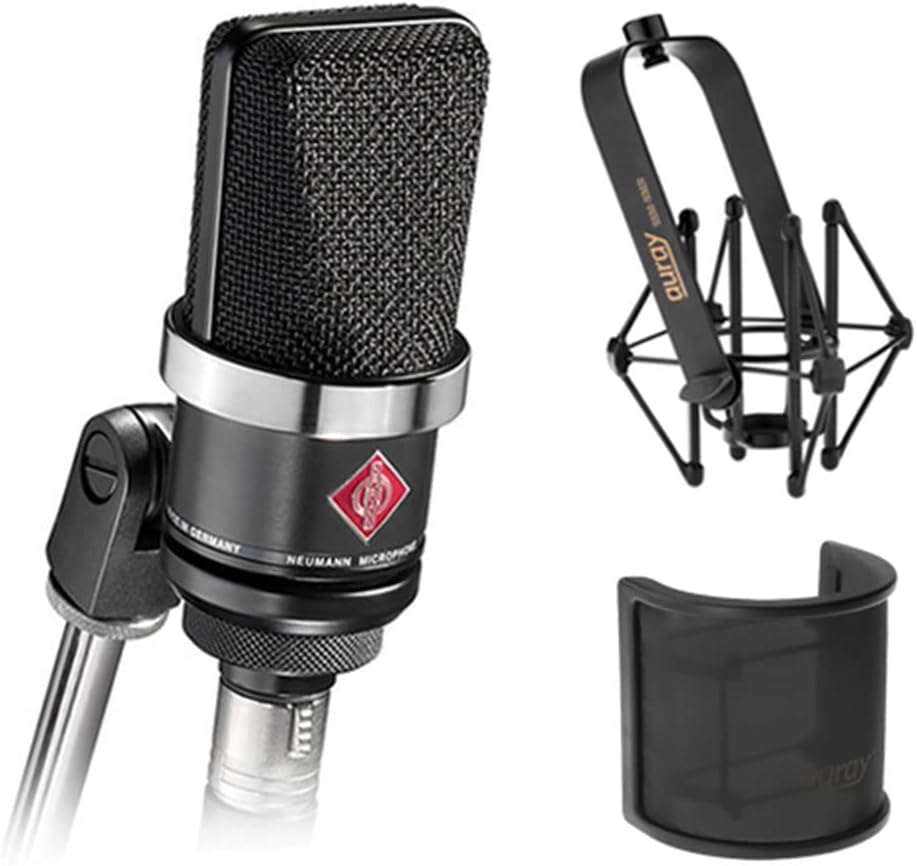Neumann TLM 103 Review
When it comes to microphones, few names carry the weight and prestige of Neumann. For nearly a century, this German manufacturer has set the standard for professional audio recording, with iconic models like the U87 becoming staples in studios worldwide. But not every studio—or home recordist—can justify the steep price tag of a U87. Enter the Neumann TLM 103, a microphone designed to bring that coveted Neumann sound to a broader audience at a more accessible price point. Introduced in 1997, the TLM 103 has since carved out its own legacy, often hailed as a “modern update” to the U87. But does it live up to the hype? In this review, we’ll explore every facet of the Neumann TLM 103—its design, sound quality, technical prowess, real-world applications, and where it stands in today’s competitive microphone market.
Neumann TLM 103 Review
The Neumann TLM 103 is a large-diaphragm condenser microphone with a fixed cardioid polar pattern. Priced around $1,100-$1,300 USD (depending on the retailer and accessories), it’s positioned as an “affordable” option within Neumann’s lineup—though it’s still a significant investment for many. The “TLM” in its name stands for “Transformerless Microphone,” a design choice that eliminates the output transformer found in classic Neumann models like the U87, aiming for a cleaner, more immediate sound with reduced signal loss.
Out of the box, the TLM 103 exudes quality. Available in satin nickel or matte black finishes, it sports a sleek, compact design that echoes the iconic Neumann aesthetic—think a slightly stubby cousin of the U87. The microphone weighs in at 450 grams (just under a pound), giving it a reassuring heft without feeling cumbersome. It ships in a padded wooden case, a nice touch that underscores its premium status, though it comes with only a basic swivel stand mount (SG 1) rather than a shock mount, which is sold separately. For a mic in this price range, the lack of a shock mount feels like a minor oversight, but we’ll dig into that later.
Design and Build Quality
Neumann’s reputation for meticulous craftsmanship shines through in the TLM 103. The body is constructed from solid metal, with a precision-machined finish that feels both durable and elegant. The grille—a wedge-shaped, wire-mesh design reminiscent of the U87—protects the capsule while maintaining an open, unobstructed sound path. While the grille is sturdy, some users note it feels slightly less robust than the rest of the mic, though it’s unlikely to see heavy abuse in a studio setting.
Inside, the TLM 103 houses the K103 capsule, a derivative of the legendary K67 capsule found in the U87 and U67. Unlike the U87’s dual-diaphragm design, which supports multiple polar patterns, the TLM 103 uses a single-diaphragm configuration optimized for cardioid operation. This simplification reduces cost and complexity while retaining much of the K67’s tonal character. The transformerless circuitry is another key feature, promising low noise and a direct, uncolored sound—a departure from the subtle warmth transformers can impart.
The mic requires 48V phantom power and connects via a standard XLR cable (not included). Neumann claims it’s insensitive to capacitive loading, meaning you can use long cables without signal degradation—a practical perk for larger studios or live setups. Optional accessories like elastic suspensions and pop filters are available, but the base package keeps things minimal.
Technical Specifications
Let’s get into the nitty-gritty of the TLM 103’s performance specs, as these numbers tell a compelling story:
- Frequency Response: 20 Hz – 20 kHz, with a gentle presence boost above 5 kHz.
- Sensitivity: 23 mV/Pa, making it highly sensitive to subtle sound sources.
- Self-Noise: 7 dB-A, among the lowest of any microphone in its class.
- Maximum SPL: 138 dB (at 0.5% THD), capable of handling loud sources without distortion.
- Dynamic Range: 131 dB, offering exceptional headroom for both whispers and screams.
- Impedance: 50 ohms, with a rated load impedance of 1 kohm.
The standout figure here is the self-noise of 7 dB-A—an astonishingly quiet performance that outshines even the U87Ai (12 dB-A in cardioid mode). This low noise floor makes the TLM 103 ideal for capturing delicate acoustic sources or classical recordings where every nuance matters. The high maximum SPL and wide dynamic range further cement its versatility, ensuring it can handle everything from a soft vocal to a booming bass drum.
The frequency response is mostly flat, with a subtle lift starting around 5 kHz that enhances clarity and presence—perfect for vocals and instruments that need to cut through a mix. However, this boost can accentuate sibilance or harshness in some contexts, a point we’ll explore in the sound quality section.
Sound Quality
The TLM 103’s sound is often described as “pristine,” “direct,” and “modern”—but what does that mean in practice? At its core, this microphone delivers the Neumann signature: a balance of warmth, clarity, and musicality. The transformerless design strips away some of the vintage coloration of older Neumann models, resulting in a sound that feels immediate and true to the source. Compared to the U87, the TLM 103 is brighter and less “middy,” with a crisper high end and a controlled, authoritative low end.
On vocals, the TLM 103 shines. It captures every detail—breaths, consonants, and tonal nuances—with a smooth, flattering presence boost that makes voices pop without excessive EQ. The proximity effect is pronounced, so close-miking (within 6 inches) adds a rich, warm low-mid boost, ideal for intimate vocal styles. However, that same brightness can highlight sibilance or plosives, so a pop filter is a must for most singers.
For acoustic instruments, the TLM 103 is equally impressive. On acoustic guitar, it delivers a balanced tone with sparkling highs and a full body, avoiding the boxiness some mics impart. The string jangle sits beautifully in a mix, requiring minimal post-processing. When used on piano, the mic’s low noise and wide dynamic range capture both the softest notes and the loudest chords with stunning fidelity. It’s also a favorite for drum overheads or room miking, though its brightness might need taming with EQ in rock settings.
One area where the TLM 103 stands out is its off-axis rejection. The cardioid pattern narrows at higher frequencies, reducing bleed from unwanted sources while keeping off-axis sound clean and natural. This makes it a strong choice for voice-over work or podcasting in less-than-ideal acoustic environments.
Where to Use
The TLM 103’s versatility has made it a go-to for a wide range of recording scenarios:
- Vocals: Its clarity and presence boost make it a favorite for lead vocals, voice-overs, and audiobook narration. Industry pros often cite it as a standard for spoken-word applications.
- Acoustic Instruments: From guitars to strings to woodwinds, the TLM 103 excels at capturing detail and dynamics.
- Broadcast and Podcasting: The mic’s articulate sound and low noise are perfect for professional-grade spoken content.
- Spot Miking: In classical recordings, it’s often used for solo instruments like cello or double bass.
- Live Use: Artists like Jack White have used it to mic guitar amps on stage, showcasing its robustness beyond the studio.
That said, the fixed cardioid pattern limits its flexibility compared to multi-pattern mics like the U87 or AKG C414. If you need omni or figure-8 options, the TLM 103 won’t cut it.
Comparisons
How does the TLM 103 stack up against its peers?
- Neumann U87 Ai: The U87 is warmer, more versatile (with multiple patterns), and smoother overall—but it costs over $3,000. The TLM 103 is brighter, quieter, and a better value for cardioid-only needs.
- Neumann TLM 102: The smaller, cheaper TLM 102 ($700-$800) is more neutral and less refined, with a higher self-noise (12 dB-A). The TLM 103 offers a fuller, more polished sound.
- AKG C414 XLII: Priced similarly, the C414 offers multiple polar patterns and onboard controls (pads, filters), making it more flexible. However, the TLM 103 edges it out in pure sound quality and noise performance.
- Shure SM7B: A dynamic mic at $400, the SM7B is rugged and great for loud vocals or podcasting, but it lacks the TLM 103’s clarity and nuance.
Is It Worth It?
The Neumann TLM 103 isn’t perfect, but it’s damn close for what it aims to be: a high-quality, accessible condenser mic with Neumann pedigree. If you’re a serious home recordist, voice-over artist, or studio owner seeking a reliable workhorse with exceptional sound, it’s hard to go wrong here. The low noise, wide dynamic range, and musical response make it a standout at its price point. However, if you need versatility (multiple patterns, onboard controls) or are on a tighter budget, alternatives like the AKG C414 or Rode NT1 might better suit your needs.
For those who can afford it—and have a treated recording space to match its sensitivity—the TLM 103 is an investment that pays off in spades. It’s not just a microphone; it’s a statement of intent, a tool that elevates your recordings to a professional level. Whether you’re chasing the Neumann dream or simply want a mic that delivers results, the TLM 103 deserves a spot on your shortlist.
Conclusion
The Neumann TLM 103 is a modern classic that lives up to much of its reputation. It blends cutting-edge performance with the timeless Neumann sound, offering a compelling alternative to its pricier siblings. While it has its quirks—namely the lack of accessories and a slightly bright character—it’s a microphone that rewards careful use with stunning results. Whether you’re recording vocals, instruments, or narration, the TLM 103 brings clarity, depth, and a touch of magic to the table. For under $1,500, it’s not just a purchase—it’s a step into Neumann’s storied legacy.


